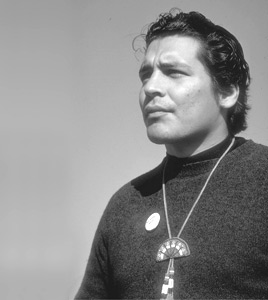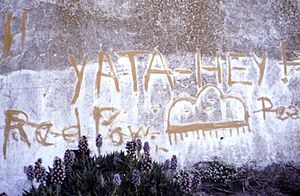Richard Oakes (activist) facts for kids
Quick facts for kids
Richard Oakes
|
|
|---|---|
 |
|
| Born | May 22, 1942 |
| Died | September 20, 1972 (aged 30) Sonoma, California, U.S.
|
| Nationality | Mohawk Nation |
| Occupation | Activist |
| Known for | Occupation of Alcatraz |
| Spouse(s) | Annie Marrufo (1960-1972) |
| Children | Bryan |
Richard Oakes (born May 22, 1942 – died September 20, 1972) was a Mohawk Native American activist. He helped start Native American studies programs in universities. He is also known for helping to change U.S. government policies about Native American peoples and their culture.
Oakes led a nineteen-month occupation of Alcatraz Island. He was joined by LaNada Means, about 50 California State University students, and 37 other people. This event, called the Occupation of Alcatraz, helped bring Native American tribes closer together.
Contents
Early Life
Richard Oakes was born on May 22, 1942. His birthplace was the St. Regis Mohawk Reservation, known as Akwesasne in the Mohawk language. This reservation is partly in the U.S. and partly in Canada. Like his ancestors, Richard spent his childhood fishing and planting.
Later, he worked at a local dock on the St. Lawrence Seaway. At age sixteen, he was laid off. After that, he became a high steelworker. This job meant he traveled a lot.
Marriage and Education
While working on the Newport, Rhode Island Bridge, Oakes met and married a woman from Bristol, Rhode Island. They had one son, Bryan Oakes, who was born in June 1968. Richard later divorced his wife and moved west.
He arrived in San Francisco and decided to attend San Francisco State University (SFSU). To support himself, Oakes worked as a bartender in the Mission District. This job helped him connect with local Native American communities.
Native American Studies and Alcatraz Plans
Oakes felt that the classes at SFSU did not offer enough about Native American culture. He worked with an anthropology professor, Dr. Bea Medicine. Together, they helped create one of the first Native American Studies departments in the country. He helped design the first courses and encouraged other Native Americans to enroll at SFSU.
Around this time, the Mohawk National Council was forming. They traveled to protest against unfair treatment of Mohawk religion. They called their peaceful protests "White Roots of Peace." In the spring of 1969, Oakes met members of this group. They encouraged him to stand up for his beliefs. Oakes also gained support from many students. He then played a key role in planning the Occupation of Alcatraz. Also in 1969, he married Annie Marrufo, who was from the Pomo Nation. Oakes adopted all five of her children.
Alcatraz Occupation

In 1969, Oakes led a group of students and Native Americans from the Bay Area to occupy Alcatraz Island. This occupation lasted until 1971. He also recruited 80 students from the American Indian Studies Center at UCLA.
Many other Native American groups had tried to reach the island by boat, but they were not successful. When boats stopped during their journey, Oakes chose to swim the rest of the way. He then took control of the island. Native Americans from many different tribes joined Oakes. They staged the longest occupation of a federal building by Native American people.
The historic occupation began with young Native American college students from San Francisco and UCLA. Oakes was seen as an important leader during the occupation, according to The American Indian Quarterly.
Oakes was in charge of the island from the start. An organizing council was quickly set up. Everyone had a job, including security, cleaning, childcare, schooling, cooking, and laundry. All decisions were made with everyone's agreement.
The occupiers stated their goal was "To better the lives of all Indian people." They wanted to "make known to the world that we have a right to use our land for our own benefit." They reclaimed Alcatraz "in the name of all American Indians by right of discovery."
In 1970, the island began to face problems. Sadly, during the occupation, Richard Oakes' 12-year-old adopted daughter, Yvonne, passed away in an accident. After her funeral, Oakes and Marrufo left the island.
Disagreements over leadership and too many non-Native American people joining the occupation weakened the original purpose. In June 1971, the United States government removed the remaining 15 occupiers from the island.
While Oakes and his followers did not get to keep the island, their actions had a big impact on U.S. policy and how Native Americans were treated. As a result of the occupation, the official U.S. government policy of ending the special relationship with Native American tribes was stopped. It was replaced by a policy of Native American self-determination, meaning tribes could make more of their own decisions.
After Alcatraz and His Death
After leaving Alcatraz, Oakes continued his activism. He helped the Pit River Tribe try to get back nearly 3 million acres of land. This land had been taken by Pacific Gas & Electric. Oakes also planned to create a "mobile university" to help Native Americans, but this idea never happened. Because of his activism, he faced tear gas, police batons, and short times in jail.
Soon after Alcatraz, Oakes was shot and killed in Sonoma, California. He was killed by Michael Morgan, a YMCA camp manager. Morgan claimed he feared for his life and shot Oakes. Morgan was charged with voluntary manslaughter. However, a jury found him not guilty, agreeing that the killing was an act of self-defense. Oakes' supporters believed the shooting was an act of murder. Richard Oakes was 30 years old when he died.
Tributes
- In 1971, musician Leon Russell released a song about the occupation called "Alcatraz" on his album Leon Russell and the Shelter People.
- In 1984, television stations showed the ballet Song for Dead Warriors. This ballet, created by Michael Smuin, was inspired by Oakes' life.
- In 1999, San Francisco State University named their new Multicultural Center after their former student. His student-led occupation helped create the American Indian Studies Department at SFSU.
- In 2012, the band Field Report honored Oakes and the Alcatraz occupation in their song "Taking Alcatraz."
- In 2016, the artist Magneto Dayo and The Lakota Medicine Men paid tribute to Oakes, Russell Means, John Trudell, and others. This was on a song called "The Journey" from the album Royalty of the UnderWorld.
- On May 22, 2017, Oakes was recognized with a Google Doodle. This marked what would have been his 75th birthday.
See also
 In Spanish: Richard Oakes para niños
In Spanish: Richard Oakes para niños

